Unit7教案
- 格式:doc
- 大小:96.50 KB
- 文档页数:16
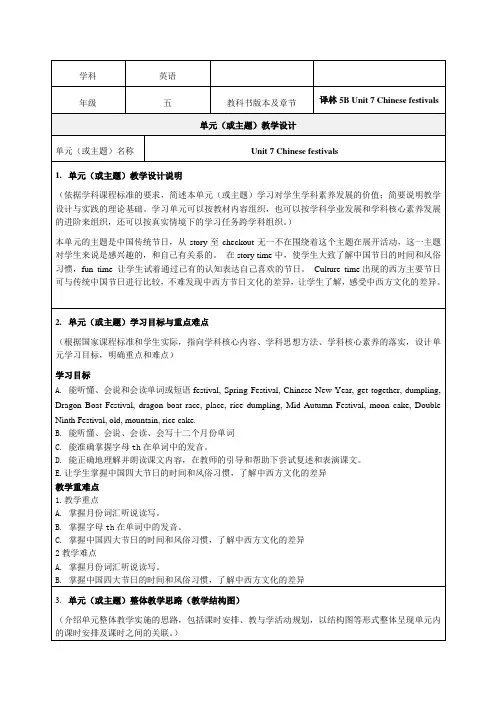
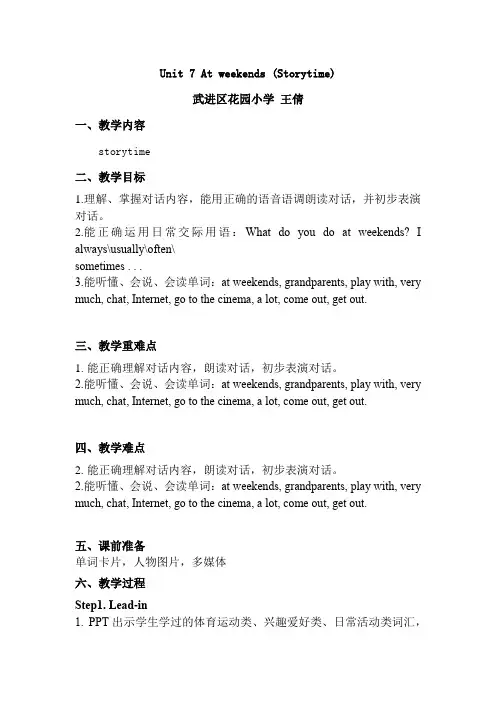
Unit 7 At weekends (Storytime)武进区花园小学王倩一、教学内容storytime二、教学目标1.理解、掌握对话内容,能用正确的语音语调朗读对话,并初步表演对话。
2.能正确运用日常交际用语:What do you do at weekends? I always\usually\often\sometimes . . .3.能听懂、会说、会读单词:at weekends, grandparents, play with, very much, chat, Internet, go to the cinema, a lot, come out, get out.三、教学重难点1.能正确理解对话内容,朗读对话,初步表演对话。
2.能听懂、会说、会读单词:at weekends, grandparents, play with, very much, chat, Internet, go to the cinema, a lot, come out, get out.四、教学难点2.能正确理解对话内容,朗读对话,初步表演对话。
2.能听懂、会说、会读单词:at weekends, grandparents, play with, very much, chat, Internet, go to the cinema, a lot, come out, get out.五、课前准备单词卡片,人物图片,多媒体六、教学过程Step1. Lead-in1. PPT出示学生学过的体育运动类、兴趣爱好类、日常活动类词汇,齐读。
T: Look at these phrases and words, you can ask your partner a question . For example: What do you like? When do you get up ? . . .Work in pairs.2.T: Boys and girls, when do you go to school in the morning?S: . . .T: We always go to school from Monday to Friday.3.PPT出九月份的日历生齐读一周七天的单词T: We always go to school from Monday to Friday. But We don’t go to school on Sunday and Saturday.PPT: on Sunday and Saturday= at weekends教读“at weekends ”Step2. Presentation and practice1. T: At weekends you don’t go to school. What do you do at weekends? S: I usually . . .Work in pairs.T: At weekends I always visit my parents, sometimes I chat with my friend on the Internet.教读此句。
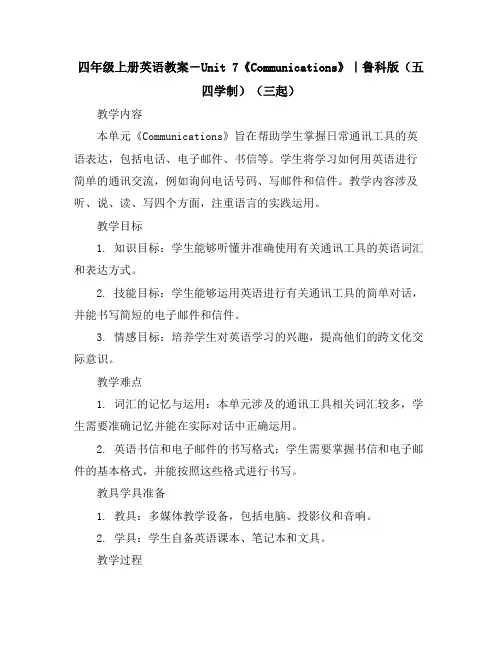
四年级上册英语教案-Unit 7《Communications》|鲁科版(五四学制)(三起)教学内容本单元《Communications》旨在帮助学生掌握日常通讯工具的英语表达,包括电话、电子邮件、书信等。
学生将学习如何用英语进行简单的通讯交流,例如询问电话号码、写邮件和信件。
教学内容涉及听、说、读、写四个方面,注重语言的实践运用。
教学目标1. 知识目标:学生能够听懂并准确使用有关通讯工具的英语词汇和表达方式。
2. 技能目标:学生能够运用英语进行有关通讯工具的简单对话,并能书写简短的电子邮件和信件。
3. 情感目标:培养学生对英语学习的兴趣,提高他们的跨文化交际意识。
教学难点1. 词汇的记忆与运用:本单元涉及的通讯工具相关词汇较多,学生需要准确记忆并能在实际对话中正确运用。
2. 英语书信和电子邮件的书写格式:学生需要掌握书信和电子邮件的基本格式,并能按照这些格式进行书写。
教具学具准备1. 教具:多媒体教学设备,包括电脑、投影仪和音响。
2. 学具:学生自备英语课本、笔记本和文具。
教学过程1. 导入:通过展示不同通讯工具的图片,引导学生复习已学的相关词汇,激发他们对本单元主题的兴趣。
2. 新课内容讲解:讲解本单元的重点词汇和句型,通过实例示范和角色扮演等方式,帮助学生理解和掌握。
3. 练习:设计相关的听、说、读、写练习,让学生在实践活动中巩固所学知识。
4. 作业布置:布置相关的课后作业,要求学生在课后进行复习和巩固。
板书设计板书设计应简洁明了,突出本单元的重点词汇和句型。
可以使用图表、颜色等手段,使板书更加生动有趣。
作业设计1. 听力练习:听懂并复述有关通讯工具的英语对话。
2. 口语练习:模拟实际场景,用英语进行有关通讯工具的对话。
3. 阅读练习:阅读相关的英语短文,并完成相关练习。
4. 写作练习:根据模板,书写一封英语电子邮件或信件。
课后反思通过本单元的教学,教师应反思教学内容是否充实,教学方法是否有效,学生是否掌握了本单元的重点知识。
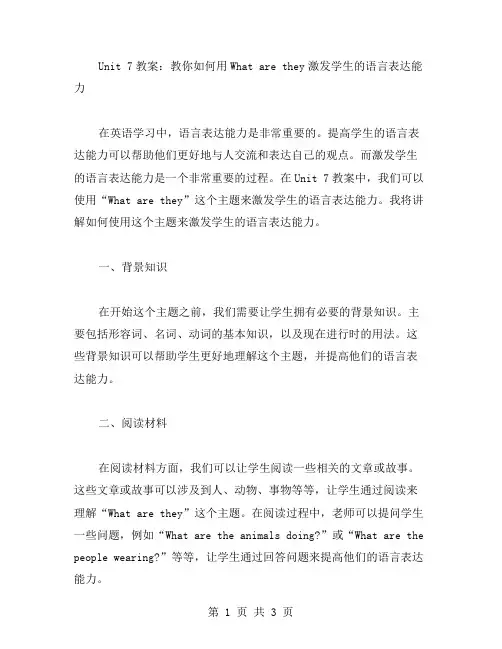
Unit 7教案:教你如何用What are they激发学生的语言表达能力在英语学习中,语言表达能力是非常重要的。
提高学生的语言表达能力可以帮助他们更好地与人交流和表达自己的观点。
而激发学生的语言表达能力是一个非常重要的过程。
在Unit 7教案中,我们可以使用“What are they”这个主题来激发学生的语言表达能力。
我将讲解如何使用这个主题来激发学生的语言表达能力。
一、背景知识在开始这个主题之前,我们需要让学生拥有必要的背景知识。
主要包括形容词、名词、动词的基本知识,以及现在进行时的用法。
这些背景知识可以帮助学生更好地理解这个主题,并提高他们的语言表达能力。
二、阅读材料在阅读材料方面,我们可以让学生阅读一些相关的文章或故事。
这些文章或故事可以涉及到人、动物、事物等等,让学生通过阅读来理解“What are they”这个主题。
在阅读过程中,老师可以提问学生一些问题,例如“What are the animals doing?”或“What are the people wearing?”等等,让学生通过回答问题来提高他们的语言表达能力。
三、口语练习在口语练习方面,我们可以让学生进行问答练习。
例如,老师可以给学生一些图片,让他们通过“What are they”这个问题来进行问答练习。
这可以帮助学生提高他们的口语表达能力,并让他们更好地理解这个主题。
四、写作练习在写作练习方面,我们可以让学生写一些有关“What are they”主题的文章。
例如,学生可以写一篇描述他们家庭成员的文章,通过“What are they”这个问题来描述他们父母、兄弟姐妹等等。
这可以帮助学生提高他们的写作能力,并让他们更好地理解这个主题。
五、游戏练习在游戏练习方面,我们可以让学生参加一些有关“What are they”主题的游戏。
例如,老师可以准备一些图片,让学生通过“What are they”这个问题来猜测图片中的物品或动物。

译林版(三起)四年级英语上册教案:Unit 7 How much一、教学目标1. 知识与技能:(1)学生能够听懂、会说、会读本课的生词和重点句子。
(2)学生能够理解句型“How much is it?”的用法,并能用所学句型询问物品的价格。
(3)学生能够理解本课的文化背景知识,了解货币的基本概念。
2. 过程与方法:(1)通过图片、实物等教学手段,创设情境,让学生在真实语境中学习英语。
(2)通过小组合作、角色扮演等活动,培养学生的英语交际能力和团队合作精神。
3. 情感态度与价值观:(1)培养学生对英语学习的兴趣和自信心。
(2)培养学生积极向上的学习态度和乐于助人的品质。
二、教学内容1. 词汇:price, expensive, cheap, yuan, dollar等。
2. 句型:How much is it? It's yuan/ dollars.三、教学重点与难点1. 教学重点:(1)句型“How much is it? It's yuan/ dollars.”的运用。
(2)生词price, expensive, cheap, yuan, dollar的正确理解和运用。
2. 教学难点:(1)句型“How much is it? It's yuan/ dollars.”中it 指代物品的价格。
(2)正确区分和运用人民币和美元的单位。
四、教具与学具准备1. 教具:多媒体课件、图片、实物等。
2. 学具:课本、练习本、文具等。
五、教学过程1. 导入新课:通过展示图片,引导学生复习已学的关于物品的词汇,为新课的学习做好铺垫。
2. 呈现新课:利用多媒体课件,呈现本课的生词和句型,让学生在真实语境中学习英语。
3. 小组合作:学生分组进行角色扮演,模拟购物场景,运用所学句型询问物品的价格。
4. 巩固练习:通过练习题,巩固所学知识,提高学生的英语运用能力。
六、板书设计1. 课题:Unit 7 How much2. 词汇:price, expensive, cheap, yuan, dollar3. 句型:How much is it? It's yuan/ dollars.七、作业设计1. 抄写本课的生词和句型。
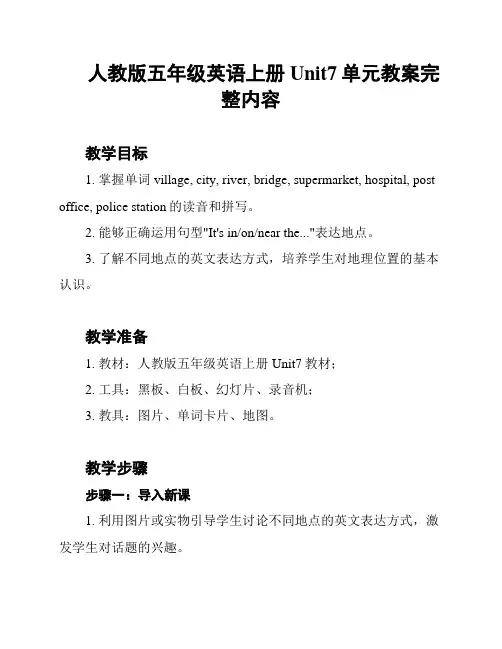
人教版五年级英语上册Unit7单元教案完整内容教学目标1. 掌握单词village, city, river, bridge, supermarket, hospital, post office, police station的读音和拼写。
2. 能够正确运用句型"It's in/on/near the..."表达地点。
3. 了解不同地点的英文表达方式,培养学生对地理位置的基本认识。
教学准备1. 教材:人教版五年级英语上册Unit7教材;2. 工具:黑板、白板、幻灯片、录音机;3. 教具:图片、单词卡片、地图。
教学步骤步骤一:导入新课1. 利用图片或实物引导学生讨论不同地点的英文表达方式,激发学生对话题的兴趣。
2. 师生互动,教师出示图片或说出地点,让学生尝试用"It'sin/on/near the..."句型回答。
步骤二:研究新词汇1. 出示词卡片,教授新词汇,包括village, city, river, bridge, supermarket, hospital, post office, police station。
2. 全班一起跟读,注意音标和发音。
3. 进行词汇游戏,让学生快速回答单词意思。
步骤三:研究句型1. 出示"It's in/on/near the..."句型的语法结构,解释其用法和意义。
2. 通过示范和练,让学生掌握这个句型,并能够用于不同地点的描述。
步骤四:综合运用1. 教师出示地图上的不同地点标记,让学生运用所学的句型描述地点。
2. 学生之间互相提问,回答对方的问题,巩固句型运用。
3. 进行小组活动,让学生分组描述自己所在的位置,并展示给全班。
步骤五:巩固和评价1. 制作练题,包括选择题、填空题等,帮助学生巩固所学内容。
2. 进行反馈和评价,根据学生的表现给予肯定和建议。
教学延伸1. 学生可以在班级或家庭中进行实地考察,使用所学的句型描述不同地点。
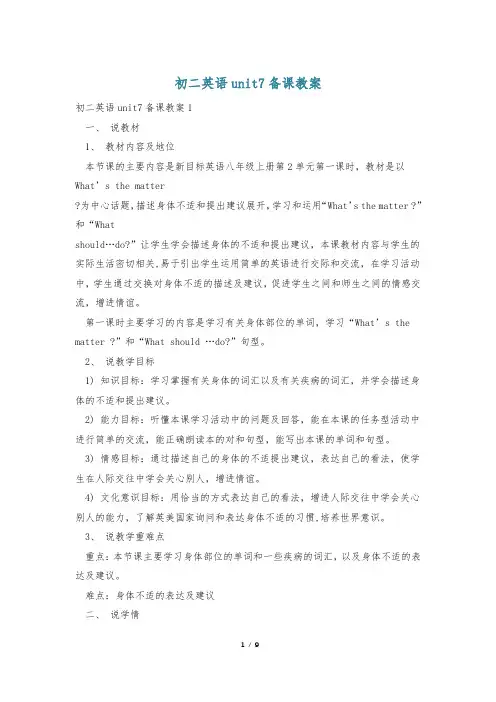
初二英语unit7备课教案初二英语unit7备课教案1一、说教材1、教材内容及地位本节课的主要内容是新目标英语八年级上册第2单元第一课时,教材是以What’s the matter为中心话题,描述身体不适和提出建议展开,学习和运用“What’s the matter ?”和“Whatshould…do?”让学生学会描述身体的不适和提出建议,本课教材内容与学生的实际生活密切相关,易于引出学生运用简单的英语进行交际和交流,在学习活动中,学生通过交换对身体不适的描述及建议,促进学生之间和师生之间的情感交流,增进情谊。
第一课时主要学习的内容是学习有关身体部位的单词,学习“What’s the matter ?”和“What should …do?”句型。
2、说教学目标1) 知识目标:学习掌握有关身体的词汇以及有关疾病的词汇,并学会描述身体的不适和提出建议。
2) 能力目标:听懂本课学习活动中的问题及回答,能在本课的任务型活动中进行简单的交流,能正确朗读本的对和句型,能写出本课的单词和句型。
3) 情感目标:通过描述自己的身体的不适提出建议,表达自己的看法,使学生在人际交往中学会关心别人,增进情谊。
4) 文化意识目标:用恰当的方式表达自己的看法,增进人际交往中学会关心别人的能力,了解英美国家询问和表达身体不适的习惯,培养世界意识。
3、说教学重难点重点:本节课主要学习身体部位的单词和一些疾病的词汇,以及身体不适的表达及建议。
难点:身体不适的表达及建议二、说学情初二年级的学生对英语已经有了一定的基础,但本地区部分学生对学习英语的兴趣不是很浓,在学习中,他们更喜欢从游戏中或活动中学习,这样更能提高他们的学习兴趣,让他们更轻松地掌握英语知识。
三、说教法作为教学的引导着,我遵循新课程“学生是学习的主人,一切的教学活动设计在以学生为本”的教学理念,坚持“为学生的发展,必须培养学生的自主性、能动性、独立性和创造性”的教学原则。
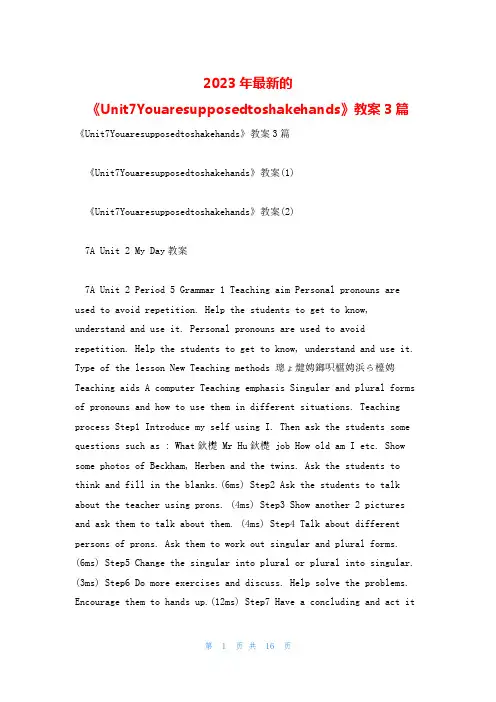
2023年最新的《Unit7Youaresupposedtoshakehands》教案3篇《Unit7Youaresupposedtoshakehands》教案3篇《Unit7Youaresupposedtoshakehands》教案(1)《Unit7Youaresupposedtoshakehands》教案(2)7A Unit 2 My Day教案7A Unit 2 Period 5 Grammar 1 Teaching aim Personal pronouns are used to avoid repetition. Help the students to get to know, understand and use it. Personal pronouns are used to avoid repetition. Help the students to get to know, understand and use it. Type of the lesson New Teaching methods 璁ょ煡娉鎯呮櫙娉浜ら檯娉Teaching aids A computer Teaching emphasis Singular and plural forms of pronouns and how to use them in different situations. Teaching process Step1 Introduce my self using I. Then ask the students some questions such as : What鈥檚 Mr Hu鈥檚 job How old am I etc. Show some photos of Beckham, Herben and the twins. Ask the students to think and fill in the blanks.(6ms) Step2 Ask the students to talk about the teacher using prons. (4ms) Step3 Show another 2 pictures and ask them to talk about them. (4ms) Step4 Talk about different persons of prons. Ask them to work out singular and plural forms. (6ms) Step5 Change the singular into plural or plural into singular. (3ms) Step6 Do more exercises and discuss. Help solve the problems. Encourage them to hands up.(12ms) Step7 Have a concluding and act itout. (8ms) Review what we learnt today. Practise by introducing one friend to others in class. The teacher may offer some questions, such as: What is his/her name How old is he/she How many people are there in the family Who are they What鈥檚 his/her hobby etc. They can also ask and answer. Encourage them to act it out in front of the class. Step8 Homework. (2ms) Describe his/her best friend.(50 words) The article must include the followings: What is his/her name How old is he/she How many people are there in the family Who are they What鈥檚his/her hobby Tell the students how to write such an article. We may begin like this: I have a friend鈥Jone is my best friend鈥We can end like this: I like him very much. We are best friends. This is my friend. etc. If time is free, do it in class. Design of writing Unit 2 Grammar1 Pronouns or prons. I you we Beckham he the girl she the boys they 鏁欏鍚庤鑻辫涓嶅悓浜庡叾浠栧熀纭€瀛︾ ,瀹冩槸涓€闂ㄥ疄璺佃 ,鍏惰瑷€鎶€鑳芥槸闇€瑕侀€氳繃瀛︾敓涓汉鐨勫疄璺垫墠鑳藉煿鍏诲拰鎻愰珮.鍦ㄦ暀鏈妭璇硶璇句腑,鍏朵富瑕佸唴瀹规槸浼氬簲鐢ㄤ汉绉颁唬璇嶇殑涓绘牸銆傚畠鐨勬暀瀛﹀悗鏋滃簲浠ュ鐢熺殑瀛︿範鏁堟灉涓轰緷鎹鑰屽涔犳晥鏋滃湪寰堝ぇ绋嬪害鍙栧喅浜庡鐢熺殑涓昏鑳藉姩鎬у拰鍙備笌鎬鍗冲鐢熸槸鍚︾煡閬撳湪闄岀敓浜洪潰鍓嶇敤"I am ..." "He is ..."鏉ヤ粙缁嶈嚜宸辨垨鍒汉,浼氳 ,鏁㈣ ,鑳借鏄繖鑺傝鐨勬暀瀛︾洰鏍囷紟鍥犳 ,璇惧爞鏁欏蹇呴』浠ュ鐢熶负涓績,鏁欏蹇呴』鍏呭垎璋冨姩瀛︾敓鐨勭Н鏋佹€鏈夋晥鐨勭粍缁囦互瀛︾敓涓轰腑蹇冪殑鐢熷姩,娲绘臣鐨勮鍫鍙婃椂鍙戠幇浠栦滑鐨勫洶闅涓轰粬浠帓闄ゅ洶闅鎴愪负浠栦滑瀛︿範鐨勫紩璺汉.鎹㈠彞璇濊 ,鏁欏笀鏄鍫傛暀瀛︾殑缁勭粐鑰绠$悊鑰榧撳姳鑰鍚堜綔鑰呭拰瑙i毦鑰咃紟浣嗘槸鐢变簬鏄娉曡锛屽湪瀛︾敓娲诲姩鏈夋晥缁勭粐涓婁粛鐒堕渶瑕佽繎涓€姝ュ湴鏀硅繘銆7A Unit 2 Period 6 Grammar2Teaching aim Different kinds of鈥渢o do鈥漵 used after personalpronouns. Learn to use 鈥渢o do鈥漣n the positive and negative sentences Help the students to use personal pronouns to describe what we do in a day. Type of the lesson New Teaching methods 璁ょ煡娉浜ら檯娉鎿嶇粌娉Teaching aids A computer Teaching emphasis Different pronouns are followed by different verb 鈥渢o do鈥 Do more exercises. Refer to the text we learnt before. How to use what we learn to describe what we do in a day. Teaching process Step1 Class begins. Show the aims of the lesson. Ask the students some questions like: Who are you How is your father How old is your mother etc. to review the personal prons we learnt before. Write them down on the blackboard. Step2 Ask questions like: Do you have any good friends What are they like Are they 14 years old Do they have much homework Do you often play together They show the third slide. Ask them tofill in the blanks. Step3 Talk about the hobbies of the students. Ask: Do you like swimming Does Lucy like swimming Do they like watching etc. Then open the fourth slide. Fill in the blanks. Do more practice about the third person. Pay attention to the usage of 鈥渄oes鈥 Open the fifth and sixth slide. Ask the students to talk about their own and their friends鈥hobbies. Let them have a concluding of the usage of 鈥渄oes鈥 Write them down on the blackboard. Step4 Open the seventh slide. Ask the students to talk about the singing club. After filling the blanks, ask the students to read by themselves and answer the questions about Miss Zhang. Step5 Open the eighth slide. First fill in the blanks. Then ask :Does she go to school by bike Does she have time to chat with her classmates etc. Then do the same as the ninth slide. Group the students into six or eight to talk about one of them. Then ask them to make a dialogue. Have a competition to see who is the best. Step6 Ask the students: Do youhave any friends Do you often write letters Do you talk about your family etc. Then, open the tenth and the eleventh slide t fill in the blanks. Answer the questions after going over the letter again. Step7 Ask the students what we have learnt this class. Then do some exercises. Help any time. Encourage them to ask questions. Step8 Homework. Help them solve the problems. Design of writing Unit 2 Grammar2 I we you she he it they Do I (you, we, they) like鈥Yes, I (you, we, they) do. Does he (she ,it, Lucy) like鈥Yes, he (she ,it, Lucy) does. 鏁欏鍚庤 1锛鏈妭鏄娉曠殑绗簩璇炬椂锛屽唴瀹规槸鍏充簬Do鍜Does鏋勬垚鐨勪竴鑸枒闂彞鐨勭敤娉曪紝骞朵笖鑳界敤鎵€瀛︾殑涓滆タ杩涜涓€浜涗氦娴併€傚繀椤昏繘琛屽ぇ閲忕殑璁粌銆2锛庡鐢熸椿鍔ㄥ鏄撳紑灞曪紝浣嗘槸璇濋鍙湁涓€涓紝浼氫娇瀛︾敓瑙夊緱寰堟灟鐕ャ€傚洜姝よ姹傛暀甯堣兘缁勭粐濂芥暀瀛︼紝閲囧彇澶氭牱鍖栫殑鎵嬫璋冨姩瀛︾敓鐨勭Н鏋佹€с€《Unit7Youaresupposedtoshakehands》教案(3)Unit Seven Music一、教学目标1、语言知识:词汇:(理解、运用以下词汇)accelerate, fatigue, induce, lull, competent, attributable, commit, ensure, at the wheel, slow down, in honor of, 等。
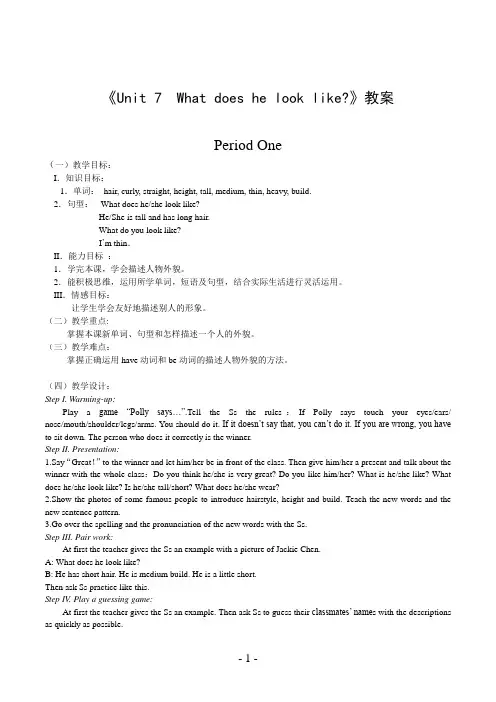
《Unit 7 What does he look like?》教案Period One(一)教学目标:I.知识目标:1.单词:hair, curly, straight, height, tall, medium, thin, heavy, build.2.句型:-- What does he/she look like?--He/She is tall and has long hair.--What do you look like?--I’m thin.II.能力目标:1.学完本课,学会描述人物外貌。
2.能积极思维,运用所学单词,短语及句型,结合实际生活进行灵活运用。
III.情感目标:让学生学会友好地描述别人的形象。
(二)教学重点:掌握本课新单词、句型和怎样描述一个人的外貌。
(三)教学难点:掌握正确运用have动词和be动词的描述人物外貌的方法。
(四)教学设计:Step I. Warming-up:Play a game “P o lly says…”.Tell the Ss the rules:If Polly says touch your eyes/ears/ nose/mouth/shoulder/legs/arms. You should do it. If it doesn’t say that, you can’t do it. If you are wrong, you have to sit down. The person who does it correctly is the winner.Step II. Presentation:1.Say“Great!”to the winner and let him/her be in front of the class. Then give him/her a present and talk about the winner with the whole class:Do you think he/she is very great? Do you like him/her? What is he/she like? What does he/she look like? Is he/she tall/short? What does he/she wear?2.Show the photos of some famous people to introduce hairstyle, height and build. Teach the new words and the new sentence pattern.3.Go over the spelling and the pronunciation of the new words with the Ss.Step III. Pair work:At first the teacher gives the Ss an example with a picture of Jackie Chen.A: What does he look like?B: He has short hair. He is medium build. He is a little short.Then ask Ss practice like this.Step IV. Play a guessing game:At first the teacher gives the Ss an example. Then ask Ss to guess their classmates’ name s with the descriptions as quickly as possible.Step V. Activity1a—1b:1. Let the Ss look at the picture at page 41 and match the people in the picture with the words. And check the answers together by using:C has short hair.D is tall.2. Let the Ss listen Activity 1b carefully, fill in the blanks in the picture at page 41 and find Amy’s friend. We can listen twice.The first time, just listen.The second time,listen and fill in the blanks.And say something about Amy’s friend’s look.( He's really tall.And he has curly hair.)Step VI. Draw and describe:Ask Ss to draw a picture of “What do you look like when you are 20 years old? ” and describe it.Step VII. Motto:Tell the Ss: Don’t judge people by their appearances!Step. VIII. Homework:1. Remember all of the new words.2. Do the Ex. in the Ex. Book.3.Write a short passage about what your favorite teachers look like.After-class consideration:Period Two(一)教学目标:I.知识目标:1.单词:always, captain, popular, team, good-looking, a little bit, joke, never, stop,brown, blonde, beard, glasses. 2.句型:同第一课时。
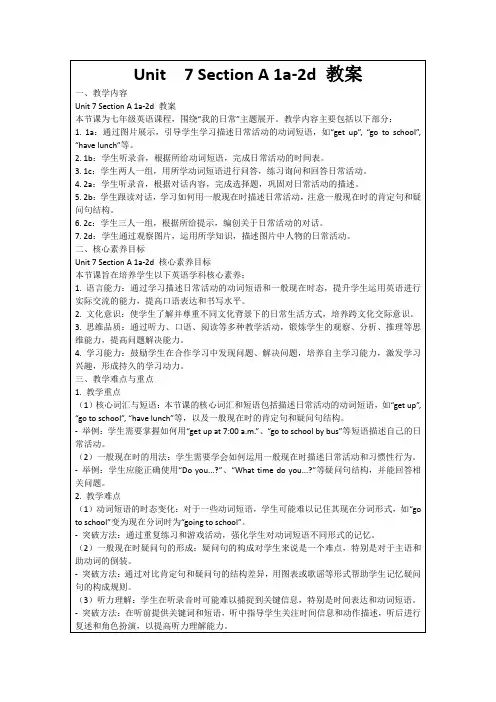
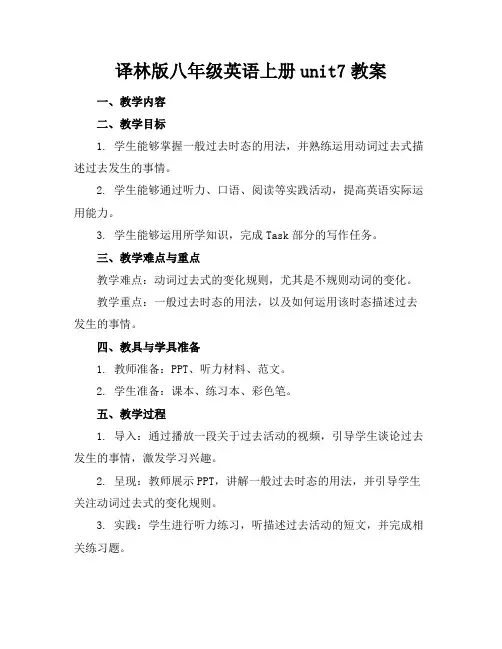
译林版八年级英语上册unit7教案一、教学内容二、教学目标1. 学生能够掌握一般过去时态的用法,并熟练运用动词过去式描述过去发生的事情。
2. 学生能够通过听力、口语、阅读等实践活动,提高英语实际运用能力。
3. 学生能够运用所学知识,完成Task部分的写作任务。
三、教学难点与重点教学难点:动词过去式的变化规则,尤其是不规则动词的变化。
教学重点:一般过去时态的用法,以及如何运用该时态描述过去发生的事情。
四、教具与学具准备1. 教师准备:PPT、听力材料、范文。
2. 学生准备:课本、练习本、彩色笔。
五、教学过程1. 导入:通过播放一段关于过去活动的视频,引导学生谈论过去发生的事情,激发学习兴趣。
2. 呈现:教师展示PPT,讲解一般过去时态的用法,并引导学生关注动词过去式的变化规则。
3. 实践:学生进行听力练习,听描述过去活动的短文,并完成相关练习题。
4. 互动:学生两人一组,运用一般过去时态进行口语练习,描述过去的活动。
5. 课堂活动:Fun with English部分,学生进行小组活动,用英语分享自己的过去经历。
6. 作业指导:Task部分,教师引导学生根据范文进行写作,描述过去的一次活动。
六、板书设计1. 一般过去时态的用法2. 动词过去式的变化规则3. 描述过去活动的句型结构七、作业设计1. 作业题目:请运用一般过去时态,描述你上周六的一天。
2. 答案:My last Saturday was busy but interesting. I got up at 7:00 and had breakfast with my family. Then I went to the library with my friend. We borrowed some books and read them together. In the afternoon, I played basketball with my classmates. We had a great time. Finally, I watched a movie at home in the evening.八、课后反思及拓展延伸1. 反思:本节课学生对于一般过去时态的掌握程度较好,但在动词过去式的变化上仍有一定困难,需要在今后的教学中加强巩固。
七上英语第七单元教案简单教学目标:1. 知识与能力:学生能够掌握本单元的重点词汇和语法知识,能够正确运用所学知识进行听、说、读、写等方面的语言运用。
2. 情感态度价值观:通过本单元的学习,培养学生对英语学习的兴趣,增强学生的自信心,激发学生学习英语的积极性。
3. 学科交叉:通过本单元的学习,培养学生的观察、分析和解决问题的能力,提高学生的语言综合运用能力。
教学重点难点:1. 重点:掌握本单元的重点词汇和语法知识,能够正确运用所学知识进行听、说、读、写等方面的语言运用。
2. 难点:培养学生的观察、分析和解决问题的能力,提高学生的语言综合运用能力。
教学过程:一、导入(5分钟)通过播放一段与本单元主题相关的视频或图片,激发学生对本单元主题的兴趣,引导学生进入学习状态。
二、学习新词汇(10分钟)1. 教师给学生介绍本单元的重点词汇,并通过图片、音频等方式帮助学生掌握单词的发音和意义。
2. 学生跟读单词,加深记忆。
三、学习新语法(15分钟)1. 教师通过例句或对话的方式向学生介绍本单元的语法知识,如动词的时态、形容词的比较级和最高级等。
2. 学生进行语法知识的操练,加深理解。
四、听力训练(15分钟)1. 教师播放与本单元相关的听力材料,要求学生听懂内容,根据问题进行回答。
2. 学生进行听力训练,提高听力理解能力。
五、口语训练(15分钟)1. 教师设计相关的口语练习题目,要求学生进行口语练习,如对话、情景对话等。
2. 学生进行口语练习,提高口语表达能力。
六、阅读训练(15分钟)1. 教师布置相关的阅读材料,要求学生阅读并回答问题。
2. 学生进行阅读训练,提高阅读理解能力。
七、写作训练(15分钟)1. 教师设计相关的写作练习题目,要求学生进行书面表达。
2. 学生进行写作训练,提高书面表达能力。
八、复习总结(5分钟)1. 教师对本节课的学习内容进行复习总结,强化学生对知识点的记忆。
2. 学生进行知识点的复习总结,巩固所学知识。
用将来时.I can finish the work in two days.我两天之内能完成这项工作。
She will graduate in two years.她两年后毕业。
2)after指以过去时间为起点的“在一段时间以后”,所以与过去时态连用。
当after指某个特定的未来时刻或日期之后,或指一将来某一时间为起点的若干时间之后时,他可以与将来时态连用。
Eg.He started on Sunday and arrived in Beijing after three days.他周日启程三天后抵达的北京。
I’ll be back after three o’clock.他三点之后回来。
4.There will be fewer people.会有较少的人There will be less free time. 较少的空闲时间There will be more pollution.更多的污染fewer 是few 比较级,其后接名词复数。
“较少的,少量的”与less 是同义。
I have fewer friends in my class.在我们班我有较少的朋友。
less 是little 的比较级,其后接不可数名词。
“较少的,少量的”more 是many 和much 的比较级即可跟不可数名词也可跟复数名词。
“更多”He has more money and more friends 他有更多的钱和更多的朋友。
There will be less pollution in the future.将来会有较少的污染。
5.(be)in great danger.处于极度危险中。
They are in great danger .他们处于极度危险中We should save animals in danger. 我们应该拯救处于危险中的动物。
6.There are already robots working in factories. There be+n. +v.ing .某地有某人正在做某事There are many girls singing in the room . 有许多女孩正在房间里唱歌。
Unit 7 It’s raining.Section A (1a-2d)一、教学目标:1. 语言知识目标:1) 能掌握以下单词:rain, windy, cloudy, sunny, snow, weather, cook, bad, park,message, take a message, could, back, problem 能掌握以下句型:①—How's the weather in Beijing?—It's sunny.②—Can I take a message for him?—Yes. Could you just tell him to call me back?—Sure, no problem.2) 能用所学的知识描述天气情况。
3)描述正在发生的动作。
2. 情感态度价值观目标:教育学生善于观察天气,善于调整自己的情绪;了解世界各地的天气情况,增加世界观念。
知道大自然的力量是神奇而伟大的,我们应当好好学习,立志学好科学知识,为长大后探索神奇的大自然,打好基础。
二、教学重难点1. 教学重点:1) The vocabulary and useful expressions.2) —How’s the weather?—It's raining/ windy.3) —What are you doing?—I'm playing basketball.2. 教学难点:运用目标语言来对天气进行问答,并且会问答其他人正在进行的活动。
三、教学过程Ⅰ. Warming-up and Lead in1. Greet the Ss and check the homework.2. Watch a video program about the weather.Ⅱ. Presentation1. (Show some pictures of the weather)Let Ss look at the pictures and ask them how the weather is.Ss learn the new words and expressions with the help of the pictures.2. Look at the pictures in 1a. Then read the new words on the right. Ask the Ss tomatch the words with pictures.3. Check the answers.Ⅲ. Game (How's the weather?)1. (Showing some pictures on the big screen.) Ask Ss "How's the weather?"2. Ss guess and answer the question.Ⅳ. Listening1. Now let's look at the city names in the box in 1b. Please read after me.Ss read the cities after the teacher.2. Now, We’ll hear four conversations. Listen carefully, point out each city in thepicture as it comes upon the tape. Play the recording a second time. Ask Ss to write the name of the city in the picture of its weather.3. Check the answers.Ⅴ. Pair work1.Tell the Ss: If you are in one of the places in the picture above. Talk about theweather with your friends in another city on the phone.2. Make a model with a student like this:T: Hi! How's the weather in Beijing?S1: It's sunny.3. Ss work in pairs. Ask and answer about the weather in the cities.Ⅵ. Listening1. Work on 2a.Let's see what Joe's families are doing. Point to the 4 pictures.2. Ask Ss tell each person is doing in each picture. More attentions should be paidto the correct use of the Present Progressive Tense.3. Play the recording for the Ss to listen and number the pictures [1-4].4. Play the tape for Ss to check the answers.5. With the whole picture, get some Ss to tell the story of it.6. BrainstormingPlay the tape for another time. Then do a memory test.Ask Ss: What's Uncle Joe/Jeff/Mary/Aunt Sarah doing?What're Scott and Lucy doing?Is Jeff watching TV? etc.7. Let Ss match the names with the activities in 2b.Play the recording for the Ss to check the answers.Ⅶ. Pair work1. Look at the pictures and talk about the people in 2a with a partner.2. Ask a student the questions as a model:T: What's Uncle Joe doing?S1: He's playing basketball.3. Ss work in pairs. Ask and answer about the pictures.Ⅷ. Role-play1. Ask Ss to read the conversation and answer the questions:①What's Steve doing?②What's Rick's brother doing?Ss read the conversations and answer the questions. Then check the answers together.2. Let Ss role-play the conversation in pairs.IX. Language points.X. ExercisesHomework:一、总结有关天气的词汇。
小学六年级英语上册Unit7备课教案一、教学目标1、知识目标学生能够掌握本单元的重点单词,如:protect, Earth, save, useful, waste 等。
学生能够理解并运用重点句型,如:We should We shouldn't 来表达应该做和不应该做的事情。
学生能够了解有关环境保护的知识,增强环保意识。
2、能力目标能够听懂关于环保的简单对话和指令。
能够用英语谈论如何保护地球。
能够阅读并理解与环保相关的简单文本。
3、情感目标培养学生爱护环境、珍惜资源的意识。
鼓励学生积极参与环保行动。
二、教学重难点1、教学重点掌握本单元的重点单词和句型。
理解并运用 We should We shouldn't 句型表达环保建议。
2、教学难点如何引导学生将所学知识运用到实际生活中,形成环保的习惯和行动。
部分单词的发音和拼写,如:protect, useful 等。
三、教学方法1、情景教学法通过创设环保相关的情景,让学生在真实的语境中学习和运用语言。
2、任务驱动法布置各种任务,如小组讨论、角色扮演等,让学生在完成任务的过程中提高语言能力。
3、游戏教学法通过有趣的游戏,激发学生的学习兴趣,巩固所学知识。
四、教学过程1、导入(Warming up)播放一段关于美丽地球的视频或展示一些地球的图片,引导学生观察并讨论地球的美丽和重要性。
提问学生:What do you think of our Earth? 引发学生的思考和讨论,从而导入本单元的主题——保护地球。
2、词汇学习(Vocabulary)展示单词卡片,依次教授本单元的重点单词,如:protect, Earth, save, useful, waste 等。
通过多种方式帮助学生记忆单词,如:读音模仿、拼写练习、单词游戏等。
结合图片和例句,让学生理解单词的含义和用法。
3、句型学习(Sentence patterns)呈现一些与环保相关的图片或情景,引导学生用 We should 或 We shouldn't 句型来表达应该做或不应该做的事情。
Unit 7 How much are these socks?一、单元教材分析本单元以谈论服装为主题,通过介绍服装,学习一些常用的服装名词;能掌握“询问价格和颜色”的句型:How much is this T-shirt? It’s seve n dollar.How much are these socks? They are two dollars.What color is it? It is red.What color are they? They are green.;掌握一些购买衣服时。
常用的语言表达方式;能阅读一些简单的服装广告信息,并能写出一些简单的广告。
通过本本单元一系列听、说、读、写的训练,让学生们会使用How much引导的问句以及回答;掌握一些表示颜色、形状、大小的形容词;学习数词10-3l;复习名词单、复数的使用和指示代词this, that,these,those的用法。
二、单元学情分析本单元的主题是谈论服装,通过学习how much和what color等引导的问句以及回答,教授学生如何询问价格和颜色;学会谈论对服装的喜好和如何购物等。
借助计算机辅助教学,将平面的语言文字内容直观化、具体化、形象化,训练学生形象思维和抽象思维能力,培养学生形象思维,深入理解语言。
积累生活的经验,提高学生的语言表达能力。
同时引导学生采用Repeating和Cooperating的学习策略,学习一些新词汇,掌握一些重点句型,在小组合作学习的过程中,培养他们团队合作精神并学会感谢人。
三、单元教学建议本单元可采用自主学习、小组合作学习、Repeating和Cooperation的学习策略,利用教学图片和制作多媒体课件来展开课堂Pairwork问答式的口语交际活动,谈论服装的价格和各自对服装的喜好。
本单元的教学法建议:语音教学可采用模仿操练的方法;词汇教学可采用演示讲解、情景操练、反复使用的方法;口语教学可采用互相操练、对话练习、交际活动的方法;阅读教学可采用补充对话和填写价格标签的方法;听力教学可采用图文配对和听写的方法;写作教学可采用看图填空、模仿写作的方法;语法教学可采用总结规律、模仿操练的方法。
四、单元课时分配本单元可用4课时完成教学任务:Section A (1a-2e) 用1课时Section A (Grammar Focus-3c) 用1课时Section B (1a-2c) 用1课时Section B (3a-Self Check) 用1课时Section A 1 (1a-2e)一、教学目标:1. 语言知识目标:1) 能掌下列词汇:socks, T-shirt, shorts, sweater, trousers, shoe, skirt, dollar, big, small, short, long, woman, need, look, pair, take2) 能掌握以下句型:①—How much is this T-shirt? —It's seven dollars.②—How much are these socks? —They're two dollars.③—Can I help you? —Yes, please.④—Here you are. —Thank you.3) 能掌握在购物时的一些常用语言,并在真实或模拟的语境下,运用所学的语言进行交际。
2. 情感态度价值观目标:该部分学习内容涉及学生的穿着,是爱美的中学生们最为关心的话题,比较贴近学生的生活,极易于激发学生的主动性和学习兴趣;同时通过购物的对话练习教学生学会如何感谢人。
二、教学重难点1. 教学重点:1) 通过听、说、读的教学活动,让学生掌握表示衣服的英语名称以及描述衣服的形容词。
2) 通过对话表演让学生在较为真实的的语境下,运用所学的语言进行购物的交际。
2. 教学难点:1)掌握一些衣服的名称。
2)通过对话表演让学生在较为真实的的语境下,运用所学的语言进行购物的交际。
三、教学过程Ⅰ. Warming-up and revision1. Greeting the Ss. Check the homework. Ask one or more students to show theirwork.2. Review the food words.S1: food: rice, hamburger, bread, chicken, milk, eggs…S2: vegetables: tomatoes, carrots, salad…S3: fruit: apples, bananas, pears, oranges, strawberries…T: Let's ask a question chain. (Ask questions one by one)S1: Do you like tomatoes?S2: Yes, I do. Do you like carrots?S3: No, I don't. I like rice. Do you like…?S4: Yes, I do. Do you like…?S5: …Ⅱ. Presentation1. T: I like shopping a lot. Do you like shopping? Now come with me to the clothes shop. (Show students a picture of a clothes shop.)T: Do you like the clothes in the shop?S: Yes, we do.T: Can you name these clothes in English?(Show a picture of a jacket.)T: What’s this in English? It’s a jacket.T: What’s this in English? It’s a T-shirt. T-S-H-I-R-T, T-shirt. Now repeat.S: T-shirt.(Show other pictures and teach Ss other clothes "socks, shorts, sweater, trousers, shoe, skirt”)2. T: So much for this. And then let's review the numbers and learn the words related to prices.T: Can you count from 0 to 9 in English?S: Yes. Zero, one, two, three, four, five…Let some students repeat that. Show some pictures of food, drink, school things, sports things with prices on the screen.Show some pictures of money from different countries, and ask students guess the names and teach them: yuan / dollar / pound. Then ask students about the prices. Help them answer.T: How much is the ice cream?S: It’s three dollar s.T: How much is the backpack?S: It’s six dollars.T: How much are the soccer balls?S: They’re 9 dollars.3. Ask the students to look at the picture on P41 and match the words with the things in the picture.T: Now let's work on 1a. We have some new words on the left of the picture and some things marked with a, b, c... and i. Please match the words with the objects in the picture by writing the letter of the objects on the lines next to the words. The first answer is given. Check the answers by asking some students to read the words and the letters.Ⅲ. Listening1. T: Next we’ll hear a conversation about shopping. The recording will be played twice. For the first time, listen to it carefully. Are you ready? OK!T: For the second time, please circle the things in the picture you hear.2. Check the answers. (Ask the students to listen to the recording and compare their answers with those in the recording.)Ⅳ. Pair work1. Ask students to work in pairs and practice the conversations in la.2. Make their own conversations with their partners.3. Ask some pairs to act out their conversations.Ⅴ. Listening1. Show students some colors by overhead projector.T: These are different colors. What colors are they?S: They are black, white, red, green, blue and yellow.2. Show a big hat and a small hat.T: Look! This hat is big. It's a big hat. And this hat is small. It's a small hat.(Write "big" and "small" on the Bb.)3. Show a long T-shirt and short T-shirt.T: Look! This T-shirt is long. It's a long T-shirt. And this T-shirt is short. It's a shortT-shirt.(Write "long" and "short" on the Bb.)4. Now look at words in 2a. Listen to the recording and repeat after the recording.(Play the tape for the Ss listen and repeat.)Ⅵ. Listening1. Ask the students to do listening to the conversations in 2b (P38) and circle the things they hear.T: Today is Sunday. Alan is shopping with her sister. They are going to buy some clothes and some other things. Now I will play the recording about the conversation.Play the recording for the first time. Listen carefully and circle the things you hear.Play the recording again to check the answers.2. Ask the students to do listening to the conversations in 2c (P38) and fill in the price tags. Play the recording and ask the students to fill in the price tags. Then check the answers.3. Ask students to listen and repeat after the recording.Ⅶ. Pair work1. Then let's ask and answer questions about the things in 2c in pairs. e.g.S1: I like these shorts. How much are they?S2: They're six dollars.2. Ss practice the conversation with their partners. Then make other conversations about the things in 2c.3. Let some Ss act out their conversations.Ⅷ. Role-play1. Mary is shopping in a clothes shop. What does she want to buy? Now read the conversation and fill in the chart below.2. Ss read the conversation with his/her partner. Discuss with his/her partner then fill the chart.3. Check the answers with the class.4. Ss practice the conversation with his/her partner. Then let some pairs role-play the conversation in front of the class.5. 评价:(让学生们对自己的表现及语言表达能力进行自我评价,在小组内评价,然后进行评出最优秀的小组。